We believe the people will be able to do things that AI will never be able to. We talk about AI as Amplified Intelligence – mixing the best of man with machine learning – the collaboration between machines and humans, science and art, data and gut feeling.
An excellent mission statement from Errol Koolmeister, Head of AI Engineering at H&M Group, during our conversation on the Future Says series. Following over 15 years of experience as Director of Data Science at ThinkBig Analytics, Lead Data Scientist at the Vodafone Group and Nordea, Errol was hired by H&M in 2018 to build out the internal AI capabilities at the firm. He is playing a central role in H&M Group’s 2025 vision to amplify all their core operational processes with AI.
Despite the well-publicised benefits of AI, a major study was recently released by MIT Sloan Management Review stating that only 10% of organisations are achieving substantial financial gains from this technology. However, it was found that companies drawing on multiple types of interaction and feedback between humans and AI were six times more likely to increase their success. “The single most critical driver of value from AI is not algorithms, nor technology — it is the human in the equation,” according to the report’s co-author. Errol agrees and this concept of Amplified Intelligence formed the basis of our discussion on Episode 4 of the Future Says series:
“At H&M Group, we have great people and with AI, we can amplify their skills. We have AI recommend what we should focus on and then we have people making the decisions.”
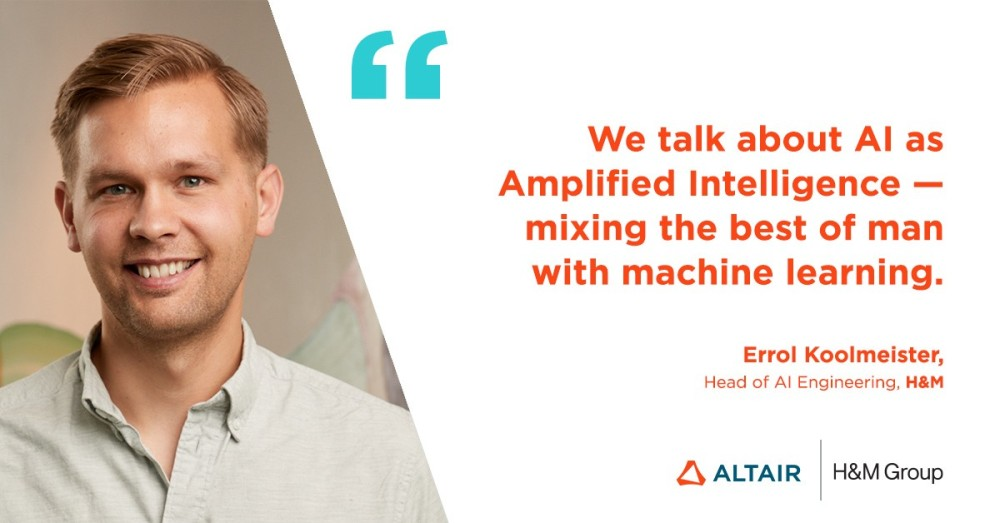

Even though the media headlines and sci-fi movies which might tell you otherwise, General AI, where robots develop emotional intelligence, is still sometime away. However, Amplified Intelligence is not. Humans should be gleaning insights from machines and applying their intellectual skills to make decisions as soon as possible. This continuous loop where humans are learning from machines and vice versa maximises both artificial and human intelligence, producing what PwC dubbed the “man-machine hybrid,” which is “more powerful than either entity on its own”. This process where AI and humans become co-dependent also ensures the negative effects of AI (as seen in Ex Machina, iRobot and the Matrix!) will not be realised. At H&M:
“We don’t run any AI without humans in the loop at this stage. I would love to get there because I have a philosophy that you should automate as much as you can, but you shouldn’t automate the things you shouldn’t.”
Alongside stopping unethical and dangerous ML, Amplified Intelligence can also benefit employees by augmenting their jobs rather than seeking to replace them. Of course, job displacement coming from increased industrialisation, is not a new concept and cannot entirely be stopped. In recent years, buttons replaced elevator operators, the Internet destroyed travel agencies and I even got help transcribing this interview using Otter.ai instead of paying a human to do the same thing! However, technology and automation has also created jobs we never thought would exist – remember that farming accounted for 31% of U.S. jobs in 1910 and now accounts for less than 1%. Errol also spoke about this history:
“Once upon a time, somebody invented cars, but what happened to all the people working with horses? I think our part in this lies in making sure there still is a place for the people that are working on the things that might be obsolete in the future. We need more people working and solving the problems, not less.”
This idea of more jobs been created via Amplified Intelligence, not less, is visualised quite nicely in the following graphic presented during the recent Gartner Data Analytics Conference.
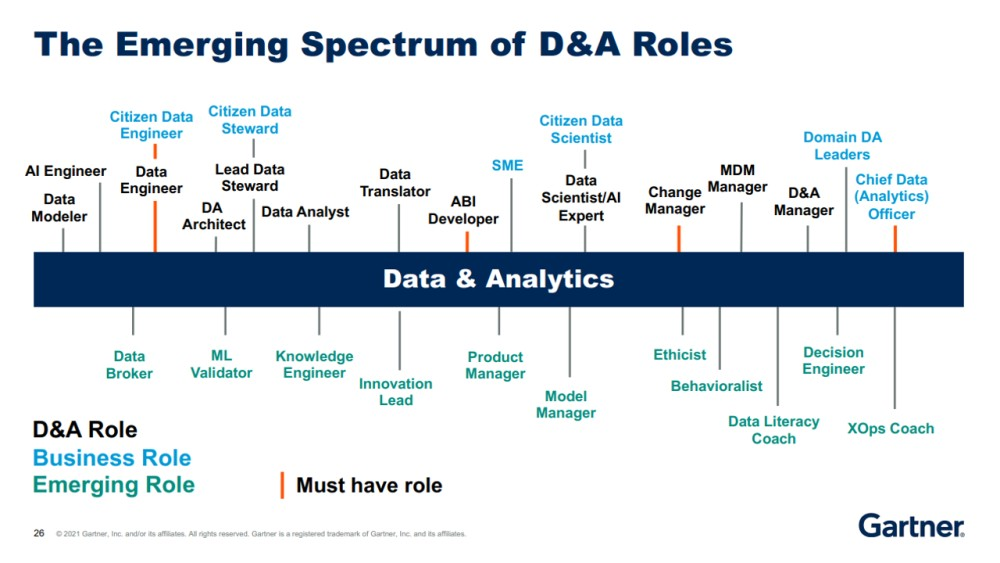

In fact, Aristotle even stated that automated harps were going to put musicians out of work back in 350 BC! Accordingly, while concerns about jobs being lost to machines are valid, new types of roles are starting to emerge associated with this trend towards Amplified Intelligence. The age-old question of whether AI will replace human workers assumes they have the same traits, but we already know that not to be the case. AI is fast and precise, but it is not intuitive, or culturally sensitive. What is easy for people can be tricky for machines, and what is straightforward for machines (analysing terabytes of data for example) remains impossible for humans. Microsoft’s Dr. Hsiao-Wuen Hon likens this amalgamation of human and machine to the two parts of a brain – computers are “the best-ever left brain” for logic and rationality, while humans create “the best-ever right brain” for originality and judgement. Therefore, while AI will radically alter how work gets done and who does it, its greater impact will be in supplementing and augmenting human capabilities. For instance, considerable time in an organisation can still be wasted on manual, time-consuming activities that could quite easily automated. By spending time on these processes, people are not using their uniquely human skills which robots will never replicate. Humans and machines need to find themselves in interdependent relationships, helping each other do what they do best. The view at H&M is:
We truly believe that humans are good at seeing the bigger picture and connecting the dots. If we can free up the humans’ time from working on the very tedious tasks, that might not be creative enough for humans, why shouldn’t we use AI for that? We want to focus on the long-tail problems with AI – for instance, in assortment quantification and demand forecasting”.
The coronavirus should be a wake-up call to reconsider how we fund education to impact this future of work and extract the benefits from Amplified Intelligence. In the past, the U.S. responded to technological change by investing in education. For example, when industrialisation transformed farming jobs in the late 1800’s, the US responded by expanding access to public schools. According to Gabe Dalporto, the CEO of Udacity, “A billion people will lose their jobs over the next 10 years due to AI, and if anything, COVID has accelerated that by about nine years”. Interestingly, the UK Government have already acknowledged this, recently committing to ‘flexible loans’ for adults wanting to retrain and upskill later in their careers. There should be a big focus on developing “fusion skills” to enable employees to work effectively at this new human-machine interface. In the industry, these are often summarised under the following headings:
- Trainers – to teach AI systems how they should perform (helping identify and reduce errors)
- Validators – to bridge the gap between data scientists and business executives (opening up the ‘black box’ as seen on the following graphic)
- Sustainers – to ensure that AI systems are operating as expected
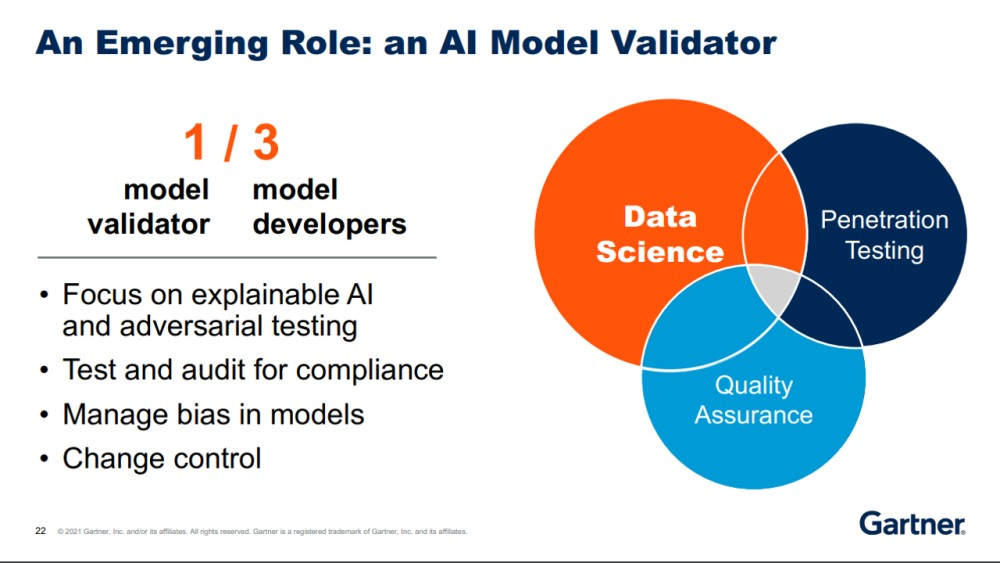

These validation roles will continue to expand and will very soon be a huge source of employment. To add further proof to the jobs Amplified Intelligence can create, Errol’s team has gone from zero to 100 over the past two years. He always has a specific toolset in mind when hiring:
“I’ve always been fascinated with the cross-pollination of different topics. At H&M, we talk about the T-shaped profile, where you specialise in one thing, but you have a lot of insight into other things. That’s the intersection, between science and art, which I think is just fascinating. At H&M, we are centred around small autonomous teams. For instance, in assortment quantification, you can have one team focus on the technical delivery side of things, one team focusing on the algorithmic, and one team focusing on the integration and rollouts. It is not about one person, it’s about a team of people delivering significant value.”
Furthermore, you can see from the following diagram, produced by the World Economic Forum, that 113 million new jobs will be created in the next year – all of which are related to data and AI.


To start gleaning the benefits from AI, organisations must focus on the areas where it can improve how a specific individual does his or her job. It is best for all if the AI agenda focusing intrinsically on helping employees by understanding their journey, their background, and how to enhance their roles. As Errol says:
“I love people and I think people are our greatest assets. AI is here to support us, not make life harder for people.”
This has been central to H&M’s transformation over the past five years.
H&M Transformation
Errol was just voted into Hyperight Nordic 100 in Data, Analytics and AI 2021 – the very same list our previous ‘Future Says’ guest, Girish Agarwal (CDIO at PIAB) – was voted on. It is no surprise as both have carried our very successful data-driven transformations at H&M and Husqvarna respectively. In my previous blog post, ‘Future Says… AI Business Model Innovation’, I touched on a lot of points which Errol agreed with – one of the most important was to start small but think big:
“We started with seven or eight high value, high visibility use cases, which were everything from fashion forecasting to demand forecasting, supplier recommendation engines, warehouse balancing, personalisation, and markdowns on the clothes. This was step one.”
Just like Husqvarna, Errol was not content with starting and ending at the PoC stage. Since Day One, he has focused on nailing it, and then scaling it. H&M have their 2025 transformation initiative, but they are firmly focused on delivering value in increments in the meantime:
“We don’t treat our projects as research projects that have very long timelines, we treat them as something that we should be able to see the value of tomorrow. We were able to produce significant amount of value to make sure our initial investments had a payback period of less than a year. We need to get out of the lab. The proof-of-concept train is leaving the station.”
Industry Challenges
As we all know, Covid-19 shook the retail industry to its core as stores around the world were forced to shut and business moved online. H&M’s HQ in Stockholm was suddenly transformed into a disaster response centre. According to Deloitte’s Retail 2021 research, the first half of 2020 saw five years of growth in online market share in a matter of weeks. Errol summed it all up by saying:
“People used to ask me who is driving our digital transformation? The CTO, the CEO, or the CIO? Recently, however, it has been the newest member of the C-Suite – COVID – which has been accelerating our digitalisation.”
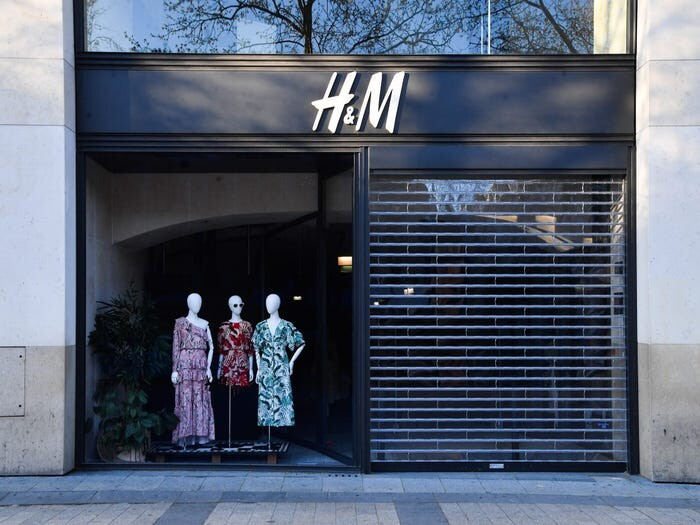

H&M believe that the future will be all about the omnichannel experience – driving content between their 5000 physical stores and 120 million online subscribers. For example:
“We are going to incorporate a lot more edge AI in the store. We will have mirrors utilising AI that could take a snapshot of you and allow you to test the dresses and find the perfect fit. How many times have we ordered things online, to see it does not fit and then send it back? It is a total waste of resources, for the company, the environment, and you as an individual. I want somebody to know me. Everybody wants to be like a rockstar – when you go into a store, the treatment you get should be fully dedicated to you and what your needs are. We call this the hyper personalised experience.”
Another big area of future growth for H&M, where AI is central, is within their sustainability initiatives. As we begin to turn the corner on the pandemic, many retailers are speaking up to ensure that the global recovery is a green one. As Errol said:
“H&M made fashion available for everyone and now we want to make sustainable fashion affordable and available for everyone. We have a responsibility to be a part of changing the world into a more sustainable place to be. We centre ourselves around three things – being fair and equal to the people and the communities around us, using our planet’s resources consciously and becoming a circular and climate positive company, as well as leading the change by pushing ourselves and the industry to reinvent and transform. At H&M, we use AI for sustainable decision-making across our value chain, both in designing and in improving our forecasting of demand – if we don’t over-forecast, there will be less waste in our supply chain, thereby having a positive impact on the world.”
In summary, AI is everywhere, and Amplified Intelligence can help you reimagine your processes to leverage the technology’s capabilities in augmenting human capacity. By giving people self-service solutions, AI can rehumanise work, allowing us more time to focus on being human instead of spending our lives thinking like machines. The difference between the winners and losers in this transformation will be determined not by whether you have implemented AI, but on how you have, and who you have involved in the process. Errol finished with a word of warning:
If you do not start using AI, there is going to be competition running on the side of you and running faster. Be prepared for change. You need to acknowledge that it is not going to happen overnight. You need to get people on board and have them as a part of the journey. If you think you can build it and they will come, you are wrong, people need to be a part of this journey.
If you want to hear this interview in full, check out altair.com/futuresays.
About the author


Sean Lang is the founder of Future Says – an interview series where he debates the pressing trends in Artificial Intelligence alongside some of Europe’s leading voices in the field. At Altair, Sean is helping educate colleagues and clients on the convergence between engineering and data science. From his background at both Altair and Kx Systems, Sean is passionate about championing data literacy and data democratisation throughout the enterprise. He believes in a future where everybody can consider themselves a data scientist.

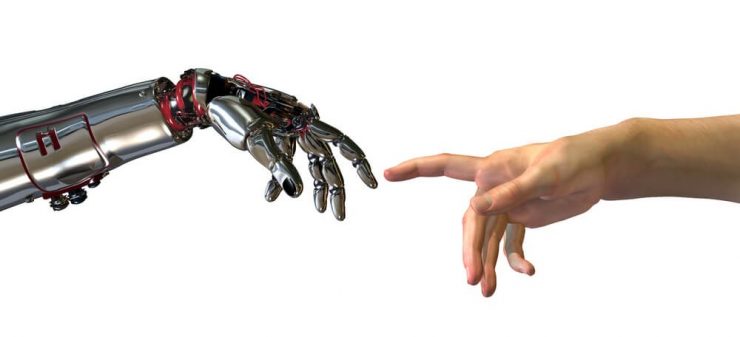













Add comment